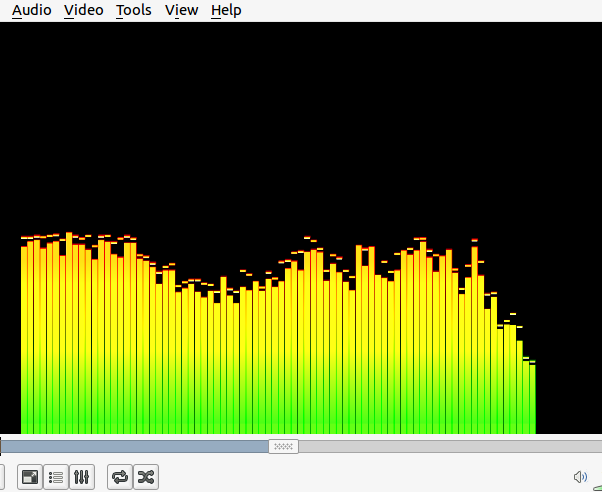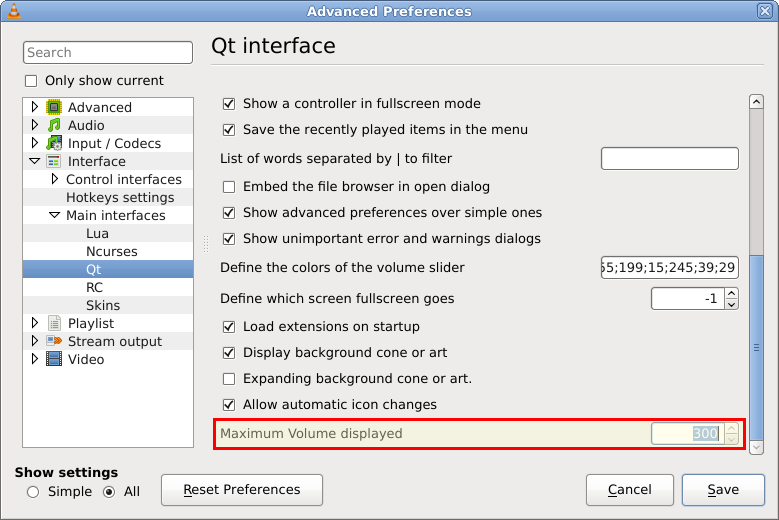Documentation:Audio
VLC can play several audio formats: .asf, .avi, .divx, .dv, .mxf, .ogg, .gm, .ps, .ts, .vob, and .wmv. It can convert audio tracks and use several visualizations.
Note: The commands in the Audio menu are only enabled when an audio file is being played.
Contents
Playing an audio track
To play a track:
- Select Open File in the Media menu.
- Select an audio file and click on the
 Play button. The selected track is played.
Play button. The selected track is played.
Enabling and disabling audio tracks
- To disable a track, select the Disable option in the Audio Track from the Audio menu. The selected track will then stop.
- To enable the track again, select the designated Track option in the Audio Track from the Audio menu. The selected track will then play.
Recording Audio
To record audio you need the record button (![]() ) to be visible. The record button is hidden by default. You can display using one of these methods:
) to be visible. The record button is hidden by default. You can display using one of these methods:
- Select Advanced Controls in the View menu. The Advanced toolbar is displayed on top of the standard toolbar. The Advanced toolbar contains the Record button.
- Select Customize interface in the Tools menu and add the record button to the Line 2 of buttons (which is the line shown by default).
Once the Record button is visible, click it to start recording.
The recording from a shoutcast stream is stored somewhere in your files under a name like vlc-record-Date-Time-Channel-Track.mp3 (e.g.: "vlc-record-2011-09-22-10h19m48s-Radio CAFF-Silencio - Arrabal Salvaje.mp3", when recording from Radio CAFF (or more precisely from the underlying WinAmp stream). Under my german Windows XP it was stored under "Eigene Dateien/Eigene Music" so I guess that you find it in an english Windows under "My Documents/My Music/", I don't know where it will be stored under Linux or any other OS (updates are welcome).
You can automagically cut the stream into tracks by relaying the stream through Streamripper, i.e. by directing StreamRipper to the ShoutCast stream and directing VLC to the relaying port of StreamRipper (default http://localhost:8000).
Audio Device
This option helps you to listen to audio files in two modes: stereo and mono.
- To listen to an audio track in either the Stereo or Mono mode, select Open File or Open Disc from the Media menu. The Open dialog box is displayed.
- Select an audio file and click on the
 Play button. The selected track is played.
Play button. The selected track is played. - Select Mono in Audio Device from the Audio menu if you want to listen to the audio track in the Mono mode.
Mono refers to monaural sound that uses a single channel for sound reproduction.
- Select Stereo in Audio Device from the Audio menu if you want to listen to the audio track in the Stereo mode.
Stereo refers to sound that uses two channels for sound reproduction or stereophonic sound.
Audio Channels
In audio, a channel refers to a stream of audio that is to be played by one speaker. For example, stereo audio, consists of two channels. This option is useful for codecs that don’t have support for more than 2 channels.
Select a channel type in Audio Channels from the Audio menu. VLC media player provides four audio channels and they are:
- Stereo – Refers to the reproduction of the sound in two or more independent audio channels using more than one speaker. If you use this option, you would feel as though the sound is played from all the directions. You can observe this in a regular home theatre with 5.1 or 6.1 speakers.
- Left – You can observe this in a regular audio player with 2.1 speakers. If you select the Left option, the music is played only in the left speaker. The speaker on your right is automatically switched OFF.
- Right - If you select the Right option, the music is played only in the speaker on your right side. The speaker on your left is automatically switched OFF.
- Reverse Stereo – There are several applications that are used to reverse the stereo whereas VLC has an in-built feature to reverse the stereo. This option is useful if you want the audio to play in tandem with the video. You can use the Reverse Stereo option if you want to deliberately change the audio output.
Imagine that you are watching a video. In the video, a person walks on the left side but the sound is produced on the right speaker. You can correct this by selecting the Reverse Stereo option in VLC. Select the Reverse Stereo option and play the same scene in the video and observe the difference.
You can observe this with 2.1, 5.1, 6.1 and 8.1 speakers.
Visualize Audio
Visualizations display splashes of colour and geometric shapes and generate animated imagery based on a piece of music.
The different visual effects available are Spectrometer, Scope, Spectrum, VU Meter and Goom. This menu item can also be used to disable a visualization.
- Select an option under the Visualizations option from the Audio menu to view the effects. The selected visualization is then played.
- To disable visualizations, select Disable under Visualizations from the Audio menu. The visualization is then disabled.
Spectrum visualization on VLC:
Maximum VLC Volume
To change the maximum volume in % that VLC should use, go to Tools → Preferences (select All at bottom left corner) → Interface → Main interfaces → Qt → Maximum volume displayed.
Save it and restart VLC.
Please read the Documentation Editing Guidelines before you edit the documentation


